
Atlas F1 Technical Writer
Brazil did not bring with it many technical changes, and the biggest challenge for the teams was the weather. Atlas F1's Craig Scarborough examines the components that made up the weekend of the Brazilian Grand Prix
Wet Weather Set-up
Before teams arrive at on a race weekend they have already prepared a set up for the car based on historical, testing and simulation data - throughout the weekend all that is left is to tune the set up to suit the drivers taste. When the weather turns wet this planning largely goes down the drain, along with the rainwater.
There is no definitive wet set up for a car as wet weather is never the same twice. The grip available from a track varies according to the volume of rain, how long it has been falling, and the amount of running on the track. These conditions vary from corner to corner, and almost minute by minute. Although teams test on artificially wet tracks this is known to be a poor replication of conditions, as invariably the track is doused on a warm day after the sun has heated the track surface, and the difference in track temperature distorts the results.
In case there is no specific set up the teams can apply to the car there is a known set of adjustment the teams can make to the car to alter its performance on the slippery track. The aim for wet weather set up is to soften the car, both to create grip from the suspension and prevent the engine or brakes breaking that grip.
Suspension-wise the team soften the springs and dampers to allow the car to move around more, keeping the tyres in generous contact with the track, as well as the anti-roll bars to improve grip for traction at the cost of more roll. The suspension is raised, which reduces downforce but keeps the plank clear of the ground, preventing the car's underbody aquaplaning on the surface water. Brakes are altered with different master cylinder ratios to improve feel at the cost of outright power, and the compound of the disc/pad combination is also softened to reduce the initial bite that can lead to lock ups.
Nowadays the engine is also a major tuning aid to reduce breaking traction and ignition, and fuel curves are altered to create a softer power delivery, both under acceleration and to prevent wheel locking on the overrun. Traction control and gear change strategies are altered again in the search of a more seamless power delivery.
Aerodynamics requires more downforce to press the tyres into better contact with the ground, as straight-line speed is already limited by the risk of aquaplaning on the straights. Engine cooling is less of an issue in the wet; ambient temperatures are lower, and the water-laden airflow is more efficient at cooling. Likewise brake cooling is reduced with smaller or taped-up ducts. Even the driver comes in for attention in the wet; visibility is critical in the spray, and visor rip-offs are not used in the wet as water gets in behind them and ruins visibility. Water repellent treatments are used, which work by surface tension forming the water film on the visor into beads so the windblast blows the visor clear.
Modern helmets feature complex ventilation systems made up of scoops and slots around the helmet to flow air in and out; in the rain less cooling ventilation is required, but more visor ventilation is called for to prevent the dreaded misting. Again chemical treatments on the visor reduce this, but it is known that washing up liquid achieves the same results, as does simply propping the visor open with a rolled up piece of duct tape. Some drivers also prefer to run clear visors to the tinted or iridescent versions for sunny days, while others use amber tinted visors that are believed to improve clarity of vision in poor lighting.
While all the above set ups and strategies are important there is no more important element than the tyres, and this year a one wet tyre type rule was enforced by the FIA. Initially put forward by the teams, it was simplification rule aimed at reducing the cost of the logistics required to bring tyres to the race. It has also been suggested that this was a ploy by the Michelin shod teams to make up for the lack of pace in the French companies wet tyre selection. As only one type of wet tyre can be brought, Bridgestone countered by noting the race director would not run the cars in full wet conditions without a safety car and accordingly they could err on the side of an intermediate tyre that would provide better pace in drying conditions. Michelin went more towards a full wet type tyre, with their intermediate tyre now featuring a full wet type tread.
Wet tyres are complex objects. As the compound and construction of the tread pattern is almost free choosing the right layout of grooves is critical. Wet tyres need to disperse the water trapped between the tyre and the track. To clear this water effectively the grooves need to have sharp edges, plus be deep and numerous enough to cope with the level of surface water.
As Michelin opted for a tread pattern made up of six small tread blocks across the tyre, the tyre's ability to clear water and generate heat make it most suitable for wetter track conditions, but as the track dries the smaller blocks of tread move around and quickly round-off the edges of the grooves, eventually overheating the rubber. Conversely Bridgestones tread pattern uses two large "U" shape tread blocks diagonally opposed across the tyre. This larger block creates less movement and hence heat, but is comparatively limited in clearing rain.
Looking at the basic design of the tyres explains the different teams fortunes at various points in the race. Initially, in very wet conditions, the Michelins performed well, providing driver confidence with grip and no aquaplaning, while the Bridgestone drivers had less grip and more aquaplaning. As the water cleared off the track and a dry line appeared the Bridgestones came into their own, running closer to their optimum temperature and having more rubber in contact with the road, while the Michelins were overheating and giving up their grip. As the race progressed the stream of water running over the track at turn three effectively gave the track two types of surface; one quite dry and one very wet. Despite running quicker around the dry part of the track the Bridgestones, with their limited water clearing ability, aquaplaned on the water and spun some helpless drivers off the track. Michelin shod teams at this point were losing out on lap times but despite the worn tyres were able to negotiate the stream with more confidence and stayed on the track.
Team by Team
McLaren
There were no changes at McLaren for the Grand Prix, with the car performed better in the wet than the other Michelin shod teams. This was not initially evident as Raikkonen spun on his first out lap in Friday, although Coulthard later completed a marathon session and came out fastest. Raikkonen had to go out first in Q1 on a very wet track but completed a clear run, whereas Coulthard had a few lock ups in Sector2 and came out the slower of the two. Q2 saw Coulthard return to his Friday set up and set a top sector1 and Sector3 times, but lost time in the tighter and longer Sector2. Raikkonen had a engine drama which was only fixed in the garage in the minutes building up to his lap, where he ran over a kerb and lost time, losing out to Coulthard on the grid by 0.05 secs.
In the race the McLaren's acceleration out of the last sequence of corners made overtaking easy, with some classy manoeuvres shown off when the drivers were impatient in traffic. Raikkonen stayed out for the second safety car period while Coulthard pitted, the team splitting their strategy with Coulthard adopting a two-stop race and Raikkonen leaving his single stop until later in the race when his tank was empty. With better pace in the wetter segments of the race the team outpaced all the Michelin runners.
Renault
Ferrari
To improve Barrichello's comfort with the HANS collar developments were tested before the race, leading to him appearing in Brazil with a new HANS device that required his wearing of Schumacher's brand of Helmet. Previously Barrichello has always worn a Japanese Arai rather than Schumacher's German Schuberth helmet. The car itself was unchanged for the weekend.
Fridays Q1 session saw Barrichello more at ease with the car than Schumacher, who lapped in slightly wetter conditions which contributed to his spin on the out lap. Again on Saturday it was Barrichello with the better lap, his teammate struggling in the longer Sector 2 with understeer. Poor acceleration in the wet saw Barrichello give up his lead after the safety car pulled in; the Ferrari's lack of grunt out of Mergulho on to the straight was a weak point all race.
Both drivers pitted at the second safety car, and on Lap 25 Schumacher spun on the water at Turn 3 to call out the third safety car period. Barrichello continued, with increasing pace as the track dried, until his car cut out and he pulled over on Lap 46 with what was initially described as a total shutdown of the car and later said to be a shortage of fuel.
Williams
Change was evident on the FW25, most of it aero related with the exception of the new gearbox with a Ferrari/McLaren-like torsion bar layout placing the dampers inside the gearbox casing. The new front wing formed the major part of the update; the curve of the wing replicated a format run by McLaren in winter testing. The wing places the deepest longest part of the wing in the middle of the outer sections. At this point the most downforce (and the resultant increased turbulence) is created. The wing strives to create the same downforce with fewer disturbances to the flows around the other parts of the car.
Overall the changes have been to improve the quality of airflow to the rear of the car, which still sports the higher downforce package seen in Malaysia. In the dry and in testing these changes have seen a marked improvement in the cars performance. Despite the changes they appeared a handful in qualifying, with Montoya locking up and also going off on his run, while Schumacher had a cleaner but slow lap on his run. Both drivers had spins on Saturdays morning session, but in Q2 both drivers had cleaner runs, with both finishing in the top ten and Montoya having the fastest speed trap time.
For the race the Williams were using up their rear tyres too quickly. By only lap 14, seven full speed laps into the race, Montoya reported problems. The Lap 18 safety car period allowed the drivers to queue up to get fresh tyres with changed pressures to prevent the problems. Only two laps after the Safety car pulled in Montoya was the first to go off in Turn 3, being closely followed by a Jaguar. Schumacher made good progress, coming in on Lap 47 for tyres and fuel, albeit losing out on track position in the process as the red flag was shown.
Jordan
Sauber
With Sauber's pace consistent all weekend the cars looking balanced, if lacking outright pace. Frentzen's Q1 run was slowed with a 'wiggle' in Sector 1, while both drivers runs in Q2 saw slow Sector 2 times ruin their otherwise fast sector times. A strategic pitlane start for Frentzen allowed him to fuel up for a long one-stop opening stint, not stopping until after everyone else for tyres and fuel, and long after Heidfeld ground to a halt on Lap 7.
BAR
A weekend of lost opportunity for BAR. Button spun his car off a wet kerb in Q1, reversing his car at high speed into polystyrene marker boards, ripping off his rear wing in the process and not coming to a stop until the next corner. Villeneuve meanwhile put in a rare wet weather performance to run seventh. Button then further suffered by having to run first in Q2, posting a time just out of the top ten, while Villeneuve's run was slowed by a poor exit out of Mergulho, which placed him behind his team mate. Both drivers pitted in the second safety car period, and after the next safety car Button found the water in Turn 3, catching the initial slide before running heavily into the barrier. Villeneuve ran well until the race's premature end.
Toyota
Straightforward laps in Q1 placed Panis and da Matta in sixth and eleventh places respectively, which boded well for the team. A spin in Turn 1 for da Matta during the Saturday morning session saw things turn sour, and both their qualifying laps saw errors resulting in grid slots on the last three rows. Starting from the grid and pitting on the end of Lap 1 gave Panis a full tank; his advance was halted when he was hit from behind by Firman's suspension-less Jordan, leading to immediate retirement. Da Matta stayed out for the second safety car period, pitting during the next period and again on Lap 35, stalling in the process. He rejoined the race but was classified last on track as the red flag was shown.
Jaguar
Brazil suited the R4, at least in Mark Webber's hands. His late run in Q1 saw a drier track placing him artificially on pole for Saturdays Q2 session, while Pizzonia, running in the spare car after a spin in the racecar in the morning, was in the top ten albeit some two seconds slower than his teammate. In the dry Q2 session Pizzonia could not convert this placing into a good grid slot, while Webber ran to an excellent third place.
Pizzonia started from the pitlane in order to get more fuel on board, not needing to stop in the second safety car period like Webber. Pizzonia spun out of the race in Turn 3, narrowly avoiding the Williams already parked in the barrier. Webber pitted once more during the fourth safety car period; he spun once in Turn 3 but was able to collect the car and rejoin the track. On Lap 54 he went off into the outside of the last corner before rebounding back to the inside of the track in a major accident; debris thrown from his car caused Alonso's accident and the subsequent red flag.
Minardi
Brazil was yet another race where the pace of the leaders was disturbed by outside factors; throughout the weekend the major upset was just one factor - rain. To have such heavy persistent rain through a race weekend so early in the year presents the teams with the problem of finding a suitable set up, and with the added complication of only one type of wet tyre per supplier the difficulties multiplied, with the relative pace between teams dependent on which tyre supplier they use. There was little technical change on the agenda this weekend, although there were a few novelties for some teams, for example Williams who brought the second wave of updates for the initially troublesome FW25.
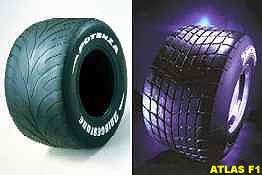 As the tyres are cooled so much by the water, and are often run in cooler weather, they need to generate enough heat to make the compound sticky, although they only need to reach half the operating temperature of the dry weather tyres. They do this not by using very soft compounds, but rather by generating movement in the surface of the tyre. As the wheel corners and accelerates the blocks of rubber in between the grooves move around; the internal friction created builds heat and helps the tyre reach its operating temperature. But this squidging of the tread blocks in drying conditions can wear the edges of the groove away and build up too much heat. This reduces the tyres ability to clear surface water and makes the compound go-off, resulting in a tyre no good for dry or wet conditions.
As the tyres are cooled so much by the water, and are often run in cooler weather, they need to generate enough heat to make the compound sticky, although they only need to reach half the operating temperature of the dry weather tyres. They do this not by using very soft compounds, but rather by generating movement in the surface of the tyre. As the wheel corners and accelerates the blocks of rubber in between the grooves move around; the internal friction created builds heat and helps the tyre reach its operating temperature. But this squidging of the tread blocks in drying conditions can wear the edges of the groove away and build up too much heat. This reduces the tyres ability to clear surface water and makes the compound go-off, resulting in a tyre no good for dry or wet conditions.
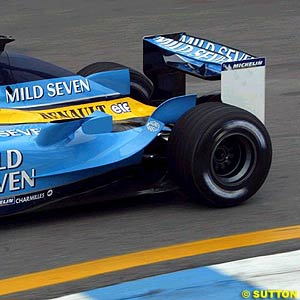 The Renault lacks power and speed on the straights, and accordingly the team's aero dept came out with the most outlandish take on the 3D rear wing seen so far. To reduce drag still further the new wing's outer sections are dramatically shortened and raised. These do not produce as much downforce but do raise the top speed of the car, with the team only 7kmh less than Williams and actually ahead of most of the rest of the field in qualifying. After 50 minutes dry running the team then had rain for the balance of the two-hour test session on Friday; Alonso also had a spin in the subsequent session. With the extra running the team were disappointing in Q1, with Trulli sliding wide in Sector 1 and losing a quarter of a second to Alonso. Roles were reversed for Q2 with Trulli's middle sector looking good, putting him four tenths up on Alonso. Despite delayed pitstops in the second Safety car period solid runs in the race placed the drivers well. Alonso was penalised with a drive-through penalty and Trulli pitted just ahead of the red flag, caused by Alonso's accident with Webber's crash debris.
The Renault lacks power and speed on the straights, and accordingly the team's aero dept came out with the most outlandish take on the 3D rear wing seen so far. To reduce drag still further the new wing's outer sections are dramatically shortened and raised. These do not produce as much downforce but do raise the top speed of the car, with the team only 7kmh less than Williams and actually ahead of most of the rest of the field in qualifying. After 50 minutes dry running the team then had rain for the balance of the two-hour test session on Friday; Alonso also had a spin in the subsequent session. With the extra running the team were disappointing in Q1, with Trulli sliding wide in Sector 1 and losing a quarter of a second to Alonso. Roles were reversed for Q2 with Trulli's middle sector looking good, putting him four tenths up on Alonso. Despite delayed pitstops in the second Safety car period solid runs in the race placed the drivers well. Alonso was penalised with a drive-through penalty and Trulli pitted just ahead of the red flag, caused by Alonso's accident with Webber's crash debris.
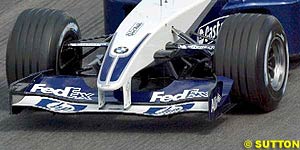 The raised middle section gives the new diffuser a cleaner flow of air, and the further raised outermost sections leave a cleaner flow around the insides of the wheels. This new wing package also feeds new front brake ducts; these reach forward around the wheel (as far as permitted in the regulations) to get a clean flow of air above the front wing, leaving a calmer wake behind them. As mentioned the floor is all new; the diffuser at the rear has been changed only in detail as the layout is visually similar, but the splitter/shadow plate under the chassis now has new short fences towards its front.
The raised middle section gives the new diffuser a cleaner flow of air, and the further raised outermost sections leave a cleaner flow around the insides of the wheels. This new wing package also feeds new front brake ducts; these reach forward around the wheel (as far as permitted in the regulations) to get a clean flow of air above the front wing, leaving a calmer wake behind them. As mentioned the floor is all new; the diffuser at the rear has been changed only in detail as the layout is visually similar, but the splitter/shadow plate under the chassis now has new short fences towards its front.
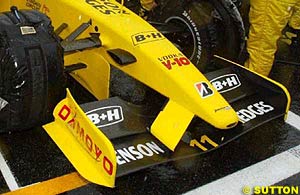 The Jordan was externally unchanged, aside from a small lip attached to the front wing mounts, but displaying better handling in the wet conditions. The Jordan pair put in clean Q1 laps. Firman spoilt a good Q2 lap with a poor opening Sector before Fisichella put the car into the top ten with a great lap. Firman took the start from the pitlane, and both drivers came in as the Race director announced the safety car was coming out in order to fuel up for the longest possible opening stint. Firman spun his car on the straight as his front suspension failed, taking out Panis' Toyota in a potentially dangerous accident. Fisichella's race saw him take the lead on his Bridgestones just as the Webber incident occurred, and he picked his way through the debris to pass the finish line just as the red flag was shown.
The Jordan was externally unchanged, aside from a small lip attached to the front wing mounts, but displaying better handling in the wet conditions. The Jordan pair put in clean Q1 laps. Firman spoilt a good Q2 lap with a poor opening Sector before Fisichella put the car into the top ten with a great lap. Firman took the start from the pitlane, and both drivers came in as the Race director announced the safety car was coming out in order to fuel up for the longest possible opening stint. Firman spun his car on the straight as his front suspension failed, taking out Panis' Toyota in a potentially dangerous accident. Fisichella's race saw him take the lead on his Bridgestones just as the Webber incident occurred, and he picked his way through the debris to pass the finish line just as the red flag was shown.
 There was a detail revision to the rear wing for this race, a notch cut out of the endplate, as seen on the McLaren and BAR for some years.
There was a detail revision to the rear wing for this race, a notch cut out of the endplate, as seen on the McLaren and BAR for some years.
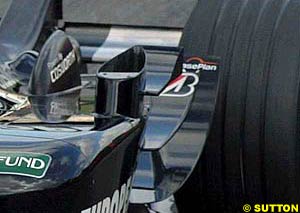 New chimneys with integrated flip ups and a return of the brake duct format seen in 2002 showed Minardi was prepared for this race. Wilson's laps were clean, but his Q1 time was 2 seconds behind Verstappen, and his straight-line speed in Q2 was 22kmh down on the Williams. Verstappen's Q1 lap was excellent but he lost his pace for Q2 and only beat his teammate. Verstappen had an engine problem in the race day warm up, starting from the pitlane in the spare with a full tank of fuel and fresh Bridgestone tyres. Wilson was the first victim of Turn 3 as early as Lap 17; Verstappen joined him there some 13 laps later.
New chimneys with integrated flip ups and a return of the brake duct format seen in 2002 showed Minardi was prepared for this race. Wilson's laps were clean, but his Q1 time was 2 seconds behind Verstappen, and his straight-line speed in Q2 was 22kmh down on the Williams. Verstappen's Q1 lap was excellent but he lost his pace for Q2 and only beat his teammate. Verstappen had an engine problem in the race day warm up, starting from the pitlane in the spare with a full tank of fuel and fresh Bridgestone tyres. Wilson was the first victim of Turn 3 as early as Lap 17; Verstappen joined him there some 13 laps later.
Please Contact Us for permission to republish this or any other material from Atlas F1.
|
Volume 9, Issue 15
Atlas F1 Exclusive
Interview with John Hogan
Ann Bradshaw: View from the Paddock
2003 Brazilian GP Review
2003 Brazilian GP Review
Technical Review: Brazilian GP
Coulda, Woulda, Shoulda
Storm Waters
Stats Center
Qualifying Differentials
SuperStats
Charts Center
Columns
Season Strokes
Elsewhere in Racing
The Weekly Grapevine
> Homepage |